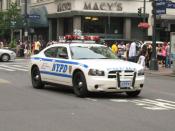When Officer Jeremy Morse arrived at the Inglewood gas station in California, Donovan Jackson was already fighting L.A. sheriff's deputies. The deputies had stopped Jackson's father for expired registration tags on his car, and were questioning him about his outdated driver's license, they say, when Jackson began attacking them. The teen then turned on Officer Morse and clawed him in the head. After the wildly thrashing teen was finally cuffed, Morse picked him up and slammed him against a patrol car. Morse's attorney claims that Jackson had gone limp and the officers did not want him on the ground as a crowd was gathering. Jackson then grabbed Morse's testicles, according to the police report filed immediately after the incident, provoking Morse to hit him in the head.
Once a suspect is restrained, an officer's right to use force against him ends totally, no matter how violent his previous behavior. Absent the facts that Morse alleges, he clearly used excessive, and hence, unlawful force.
But whether or not the teen's hold on Morse's privates legally justifies the punch (a grand jury has decided it does not), it certainly makes the blow more understandable and removes it from the realm of malice or gratuitous retaliation. For that reason, very few of the print articles on the incident, and almost none of the TV stories, tell the public about Jackson's behavior before and just after he was cuffed. The media does present the police video of the incident, but the video begins only with Jackson being thrown on the hood of the patrol car. Either anchormen and reporters are extraordinarily ill informed about the news they cover, or they have made a deliberate decision to withhold the context of Morse's punch to heighten the appearance of raw brutality. Up against such ignorant or...
![Part of the cowling for one of the motors for a B-25 bomber is assembled in the engine department of North American [Aviation, Inc.]'s Inglewood, Calif., plant (LOC)](https://s.writework.com/uploads/7/70591/part-cowling-one-motors-b-25-bomber-assembled-engine-departm-thumb.jpg)

